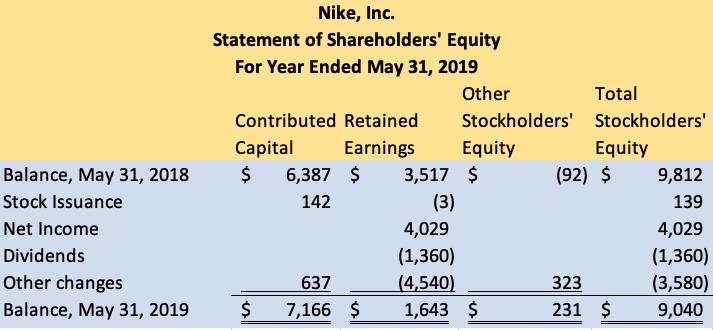
2 minute read
MINI EXERCISES
M1-19. (10 minutes)
Macy’s receives more of its financing from creditors ($14,795 million) versus owners ($6,377 million). Its owner financing comprises 30.1% of its total financing ($6,377 mil / $21,172 mil.).
Advertisement
M1-20. (10 minutes)
Coca-Cola receives more of its financing from creditors ($65,283 million) than from owners ($21,098 million). Its owner financing comprises 24.4% of its total financing ($21,098 mil./ $86,381 mil.).
M1-21. (15 minutes)
The percent of owner financing for each company follows:
The creditor percent of financing is computed as 100% minus the owner percent. Therefore, Hewlett Packard Enterprises Co is more owner-financed (29.8%) than the other two firms, while Harley-Davidson has the highest percentage of creditor (non-owner) financing (82.9% = 100% - 17.1%).
M1-22. (15 minutes)
LO 3
For its annual report dated September26, 2020, Apple reports the following amounts (in $ millions):
Assets = Liabilities + Equity
$323,888 = $258,549 + $65,339
As shown, the accounting equation holds for Apple. Also, we can see that Apple’s creditor financing is 79.8% of its total financing ($258,549 mil./$323,888 mil).
M1-23. (20 minutes)
LO 3
Nike was less profitable in the fiscal year ending May 2020 versus in the fiscal year ending May 2019 Net income was $4,029 million in the fiscal year ending May 2019 compared to $2,539 in the fiscal year ending May 2020. Note: As reported in the text, ROE was 29.7% in the fiscal year ending May 2020 compared to 42.7% in the fiscal year ending May 2019.
M1-24. (20 minutes)
LO 3 a. BS d. BS and SE g. SCF and SE b. IS e. SCF h. SCF and SE c. BS f. BS and SE i. IS and SE
M1-25. (10 minutes)
LO 1
There are many stakeholders affected by this business decision, including the following (along with a description of how):
• You/Manager your reputation, self-esteem, and potentially your livelihood can be affected.
• Creditors/Bondholders─ credit decisions based on inaccurate information can occur.
• Shareholders buying or selling shares based on inaccurate information can occur.
• Management/Employees of your company repercussions of your decision extend to them; also, your decision may suggest an environment condoning dishonesty
Indeed, our decisions can affect many more parties than we might initially realize.
M1-26. (10 minutes)
LO 4
Internal controls are rules and procedures that involve monitoring an organization’s activities, transactions, and interactions with customers, employees and other stakeholders to promote efficiency and to prevent wrongful use of its resources. They help prevent fraud, ensure the validity and credibility of accounting reports, and are often crucial to effective and efficient operations
The absence or failure of internal controls can adversely affect the effectiveness of both domestic and global financial markets. Enron (along with other accounting scandals) provided a case in point. Because the failure of internal controls can have significant economic consequences, Congress is interested in making sure that publicly- traded companies have adequate internal controls and that any concerns about internal controls are properly reported.
E1-27. (15 minutes)
LO 2
The percent of creditor financing for each company follows: Motorola Solutions: 106.4% ($11,325 mil./ $10,642 mil.); Kraft Heinz: 49.0% ($49,701 mil./ $101,450 mil.); Merck & Co: 69.1% ($58,396 mil./ $84,397 mil.).
The owner percent of financing is computed as 100% minus the owner percent. Merck is more creditor-financed than Kraft Heinz. Motorola has negative equity so their liabilities are larger than their recorded assets.
E1-28. (15 minutes)
LO 1
External users and some questions they seek to answer with accounting information from financial statements include:
1. Shareholders (investors), who seek answers to questions such as: a. Are resources owned by a business adequate to carry out plans? b. Are the debts owed excessive in amount? c. What is the current level of income (and its components)?
2. Creditors, who seek answers for questions such as: a. Does the business have the ability to repay its debts? b. Can the business take on additional debt? c. Are resources sufficient to cover current amounts owed?
3. Employees (and potential employees), who seek answers to questions such as: a. Is the business financially stable? b. Can the business afford to pay higher salaries? c. What are growth prospects for the organization?


